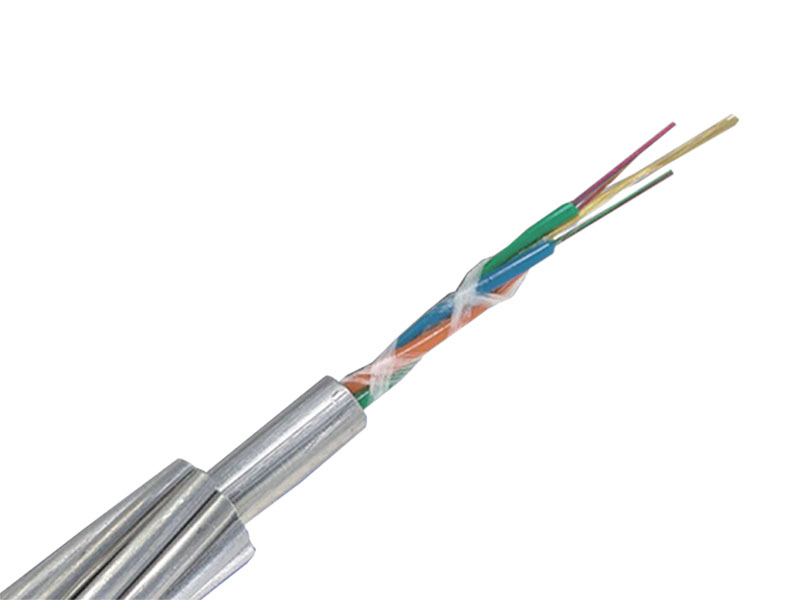
OPGW is a channel for power optical fiber communication, and also plays the role of a lightning conductor in overhead transmission lines. Therefore, the following requirements must be met in application:
Requirements and conditions for the application of OPGW optical cables in overhead transmission lines
1. First of all, the number, type, application wavelength and optical attenuation of the optical unit should be considered, and the transmission capacity required by the system, the transmission wavelength of the optical terminal and the system interface should be considered. The above requirements directly affect the composition of the optical cable, the design of the fiber core and the state of the fiber core in the OPGW.
2. As a lightning conductor, it must also meet the electrical, mechanical and physical performance requirements of the ground wire. That is, in terms of electrical performance, it should meet the short-circuit current capacity and lightning protection requirements in the system. OPGW is often used as a ground wire, supplemented by another shunt ground wire. Therefore, according to the system requirements, the single-phase short-circuit current of the busbar of the substation should be calculated, the short-circuit fault time and the shunt ratio of the two ground wires to bear the short-circuit current should be determined, and finally the minimum short-circuit current thermal capacity should be determined, thereby determining the minimum conductive metal cross-sectional area, DC resistance and diameter of the OPGW; and in terms of mechanical and physical properties, the total breaking force, elastic modulus, thermal expansion coefficient and linear weight should be met.
According to the structural characteristics of OPGW, when laying out the line, its special hardware and accessories should be used, including tension clamps, suspension clamps, anti-vibration hammers, connecting plates, fastening clamps, down conductor clamps, sag adjustment plates, jumper clamps, U-shaped hooks and junction boxes, etc.
The installation design of OPGW should consider the coordination with conductor stress, sag and insulation gap, and its load should not exceed the use range allowed by the existing tower and foundation. Therefore, the characteristic curve should be calculated according to the main technical parameters of the selected OPGW, and the layout, appearance and installation drawings of the junction box, various hardware and accessories should be designed in combination with the actual project.
1. Treatment of initial elongation
For the treatment of the initial elongation of OPGW, the cooling method can be used, that is, the aluminum-steel ratio of OPGW can be reviewed, and its initial elongation can be treated with reference to the cooling value of similar conductors or ground wires.
2. Design of anti-vibration measures
Among the hardware used in conjunction with OPGW, the tension clamp is a pre-twisted wire type, and the suspension clamp is equipped with pre-twisted wire and rubber pads. These two types of hardware have a certain anti-vibration ability. In order to further enhance the anti-vibration capability, it is possible to consider installing an anti-vibration hammer, which is generally calculated according to the span:
When the span is ≤300M, install one anti-vibration hammer;
When the span is >300M, install two anti-vibration hammers.
3. Issues to be noted in the construction and installation of OPGW
The construction and installation of OPGW is different from that of ordinary steel strands. It is necessary to prevent permanent damage to avoid affecting the performance of the optical fiber in the future, and to focus on: OPGW torsion, microbending, local radial pressure outside the clamp and contamination of the optical fiber. Therefore, the following effective measures should be taken to solve the problem during the construction phase:
(1) Prevent OPGW from twisting
Install a balance hammer and anti-twist device on the walking board and the tensioning clamp;
Use a special double-groove pulley;
Use a tension wire machine with a double winch;
(2) Prevent and reduce micro-bending and stress of OPGW
No sharp angles are allowed (control the minimum bending radius to 500mm);
The diameter of the OPGW cable drum should be no less than 1500mm;
The pulley diameter should be more than 25 times the diameter of the OPGW, and generally not less than 500mm; the inner side of the pulley should have a nylon or rubber liner to prevent scratching the surface of the OPGW;
Appropriate traction line and wire-laying hardware;
The maximum coil length of the OPGW is specified to be 6000M to prevent the number of pulleys;
The line turning angle of continuous pay-off is limited to ≤30°. In a pay-off tension section, the direction of the OPGW after the turning angle should be “C” shaped;
(3) Control of pay-off tension:
Use hydraulic tension pay-off machine and traction machine with tension release device;
Limit the pay-off speed to ≤0.5 m/s;
(4) Prevent fiber contamination
During the construction and installation of OPGW, attention should be paid to encapsulating the end;
In addition, the fiber loss acceptance test of OPGW should be carried out on site in a timely manner before the OPGW is transported to the site, before installation, after installation, and after the completion of the entire line construction.